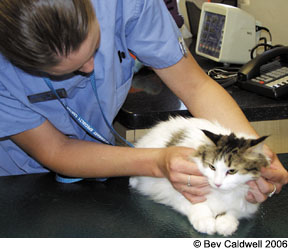If you feel tense or nervous when you visit the veterinarian with your cat, you arent alone. Chances are that your cat feels the same way. Cats read body language naturally, says ELise Christensen, DVM, a resident at the Animal Behavior Clinic at Cornell Universitys College of Veterinary Medicine. You bet they notice your tense muscles, shallow breaths and tight facial expression.

288
Veterinarians commonly see anxious pets during office visits, but your cat does not have to be one of them. The following expert tips can significantly decrease your cats anxiety at the veterinary clinic.
Dont forget the cat carrier. No matter how much your cat likes to ride on your shoulder or cuddle in your arms, he is simply safer and better off traveling in a cat carrier. Likewise for the waiting room, which might contain a dog that happens to be a great cat chaser.
Most cats never leave their one-to-three bedroom house, so riding in the car to a strange-smelling, scary clinic is asking a lot, Dr. Christensen says. To help your cat feel more comfortable in her carrier, try spraying a small amount of feline pheromone (like Feliway) in the carrier 30 to 60 minutes before traveling, and place a blanket over the carrier, she recommends.
Relax and be positive. Generally, the more your cat visits the veterinary clinic and experiences pleasant things, the more likely that he will do well there. Its best not to coddle anxious pets or tell them, Its okay, over and over again, Dr. Christensen notes. Just keep things upbeat and give good treats for good behavior.
When you bring your cat in, you have a real opportunity to teach your pet positive aspects about the veterinary experience, she notes. Your cat will learn from such experiences whether you want him to or not, so take control of the situation and convince him that its a wonderful place to be.
Some Helpful Hints
Send your kitten to class. If your veterinarian offers a kitten kindergarten class, sign up. This gives your healthy youngster the chance to experience positive handling from the veterinary clinics staff, meet other people and animals, and explore the hospital.
Schedule a party visit. If you adopt an older pet or want to correct a mild problem at the veterinary clinic, ask your veterinary staff about setting up party visits, Dr. Christensen suggests. These are times when the animal comes into the clinic for happy petting and extremely good treats, she says.
Party visits should be very short and dont need to involve the veterinarian for any length of time – just long enough to give a treat or two, she advises. Choose a quiet time at the clinic to talk with staff, give your cat treats, and sit quietly or play a game in the waiting room if it is empty.
Practice at home. Physically handling your cat in a positive way can teach her to be more comfortable with a professional veterinary exam, Dr. Christensen says. If your pet has ever acted aggressively toward you, however, seek help from a veterinary behaviorist before trying these techniques at home, she stresses.
While petting your cat, alternate between gently touching a few favorite places – such as around her ears or under the chin – with less popular places like your cats feet or tail. (Avoid touching your cats stomach, which few cats tolerate.) As your pet visibly relaxes, you can graduate to other areas, such as gently moving legs around and checking the mouth.
Nip aggression in the bud. Teaching your cat to wear a feline muzzle for brief periods of time may be the answer for a cat that becomes upset or aggressive during office visits (see CatWatch, February 2006). Talk to your veterinarian about developing a plan to help your pet calm down at the clinic. This may include a combination of desensitization and counterconditioning exercises, Dr. Christensen says. In addition, sometimes appropriate anti-anxiety medication or sedation can be helpful for these patients.
Treat her right. Forget dry kibble, which probably wont appeal to a nervous cat sitting on an exam table, Dr. Christensen suggests. Great treats that even an anxious cat will find hard to resist include boneless, skinless chicken bits or freeze-dried liver or chicken. Talk to your veterinarian about appropriate tasty options.
No dogs allowed. Choosing a cats-only clinic – or one with a separate reception area, for example – may be one of the most important things people can do to reduce feline anxiety.
Of course, daily life and emergencies do not always allow enough time to properly prepare for a veterinary visit. If your cat needs to be seen before youve had time to work on his behavior, consider making an appointment early in the day, Dr. Christensen concludes. If your pet needs to be sedated, he will have adequate time to recover before you take him home for the day.



